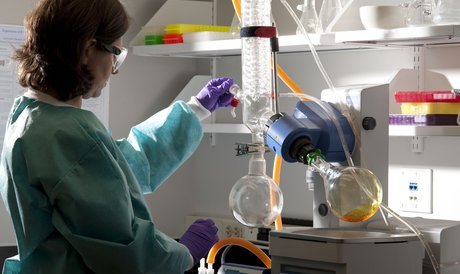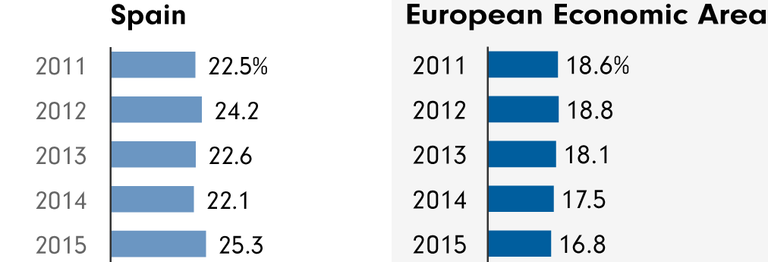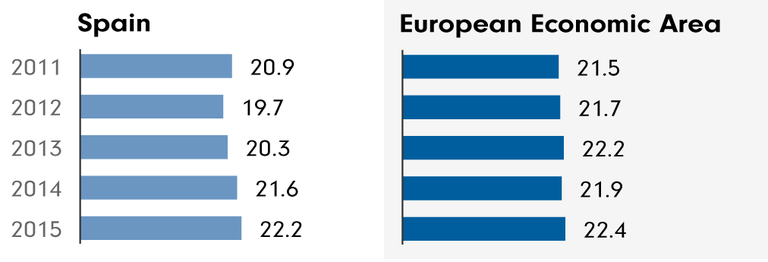
Spain
The emergence of bacteria that cause infections in humans which are resistant to treatment with antibiotics has become a global public health concern.
Infections by multi-resistant germs are estimated to kill around 25,000 people in the EU every year, with some experts estimating that this number will increase dramatically over the coming decades.
But the situation between each member states varies hugely. Some countries have strict rules around antibiotic consumption and some don’t. The EU bodies responsible for addressing the problem recognise that there is no one-size-fits-all solution. This is why it is important to understand the situation in individual countries.
MRSA prevalence
Percent of hospital Staphylococcus aureus isolates that are resistant to methicillin

Source: ECDC
Spanish antibiotic consumption
Spain uses the most antibiotics in the EU overall. In 2013 more than 2,200 tonnes of antibiotics were consumed. Although the government says it intends to take action against what is seen as a serious problem, the political will for increasing measures to tackle antibiotic resistance seems to be lacking. The National Action Plan set targets for 2014 to 2018, and each year reported on the state of affairs. But the citizens of Spain learned little about these developments.
Spain lacks detailed data on the subject. In 2011, only around 40 per cent of the hospitals had procedures to monitor the use of antibiotics. In April of this year, a special Eurobarometer public opinion survey assessed European citizens’ use and knowledge of antibiotics. Of the 27,969 interviews conducted, 1,053 were with Spaniards. The survey found that six per cent of the Spaniards who had taken antibiotics the previous year took them without a prescription. Half of the people who treated themselves with antibiotics obtained them from a pharmacy, while the other half used pills left over from previous treatments. The only other European country in which this number is higher is Austria.
Antibiotic consumption in humans
Daily doses per 1000 inhabitants per day

Source: ECDC
Hospital infections
The European Centre for Disease Prevention and Control (ECDC) also records healthcare associated infection (HAI) prevalence in European hospitals. This data shows what percentage of hospital patients have a hospital acquired infection – a large proportion of these infections are preventable, and are caused by poor hygiene.
The European average for HAI prevalence was 6.12%. In Spain, this number was above average at 8.2%.
Spain produces 6,943,600 tonnes of meat per year, making it the third highest meat producer in the EU, after France (7,165,000 tonnes). Although Spain is only the third-largest meat producer, it tops the list of countries when it comes to the amount of antibiotics consumed: 2,201.9 tonnes were sold in Spain in 2013, more than any other European country. Germany was next with 1,527.2 tonnes. This is shown by data from pharmaceutical companies.
Other indicators
An ECDC report which looked at infections and antibiotic use in European hospitals in 2011-12 reported on hospitals indicators like the use of alcohol hand rub and the number of single beds.
These indicators are important because they are measures that help to keep the rate of hospital acquired infections low, which helps to counter resistance – because the fewer infections patients acquire, the fewer antibiotics are used, and the less resistance can develop.
Single rooms are important because they can be used to isolate patients who have infections, preventing the infection from spreading. The amount of alcohol hand rub used indicates how well hospital staff are disinfecting their hands and following hygiene procedures – the more hand rub used, the less chance infections have of spreading.
Spain used less alcohol hand rub in it’s hospitals than the European average – just 14.29 litres of hand rub per 1,000 patient days, compared to the European average of 25.64 litres.
Spanish hospitals also had a lower proportion of beds in single rooms than the average. Across the European countries the ECDC gathered data on, the hospitals had on average 15.29 per cent of their beds in single rooms. In Spain this number was 9.38 per cent.
Spain also had lower than average numbers of nurses in each hospital dedicated to infection prevention and control. The European average was 0.97 full time equivalent nurses dedicated to infection control per 250 beds, in Spanish hospitals this number was 0.81.
However, Spain did have higher than average numbers of doctors in each hospital dedicated to infection prevention and control, with on average 0.79 infection doctors per 250 beds compared to the European average of 0.38.
-

-

Seven things YOU can do to combat antibiotic resistance
Because we can all help in the fight against resistant bugs.
-

A new TV documentary reveals that superbugs are multiplying in the polluted wastewater flowing from pharmaceutical plants in India
-

Less than half of antibiotics used in hospitals worldwide are prescribed appropriately, confirms a comprehensive new study
-

Projected death toll from drug-resistant superbugs 'based on incomplete data and flawed assumptions'
-

More antibiotics, more resistant germs
Antibiotic consumpion varies largely between countries
-

Lost life
More than two million Europeans are infected in hospital every year, according to the most comprehensive study to date
-

In Spain, apocalyptic scenarios of antibiotic resistance, but little action
The Spanish government has pledged to tackle the problem, with little success.
-

Fear of Bacteria
Why resistances against antibiotics has rather become an overestimated than an underestimated problem.
